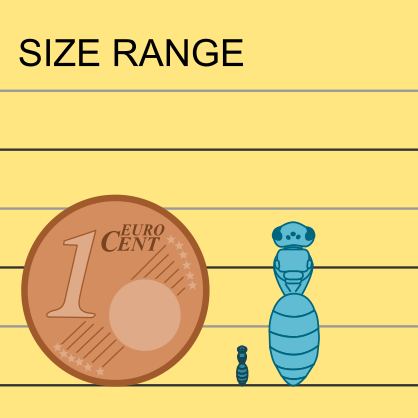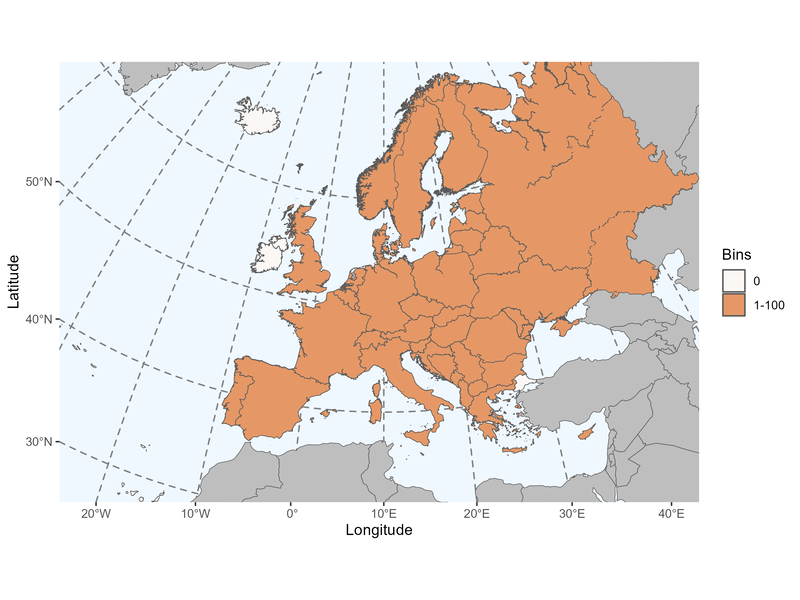Author: Latreille, 1809
|
Type species: Apis maxillosa Linnaeus, 1767 = Apis florisomnis Linnaeus, 1758, monobasic.
Subgenera: Chelostoma s.str. Latreille, 1809; Foveosmia Warncke, 1991; Gyrodromella Michener, 1997. Synonyms: Gyrodroma Thomson, 1872 (not Klug 1807). |
Clade: Anthophila
Family: Megachilidae SubF: Megachilinae Tribe: Osmiini |
|
Distinctive traits
|
Pictures of distinctive traits.
(Sorry, there is no picture available at this time. If you have some and would like to become a contributor to IDmyBee, please contact us.) |
Morphologically close genera, and how to distinguish them:
Hofferia females have no long setae on the mandible internal margin. Hofferia males do have a preapical transverse carina on S6.
Protosmia species have a propodeal triangle shorter than the metanotum. Females have a labrum with an apical tuft of hairs. In males, T7 is entirely hidden by T6.
Heriades & Stenoheriades species do have a transverse carina between the vertical and horizontal areas of the T1.
Osmia, Hoplitis & Haetosmia species do have long hairs at the apex of the labrum. Scutellum often shorter than the ITD.
- Chelostoma - Hofferia
Hofferia females have no long setae on the mandible internal margin. Hofferia males do have a preapical transverse carina on S6.
- Chelostoma - Protosmia
Protosmia species have a propodeal triangle shorter than the metanotum. Females have a labrum with an apical tuft of hairs. In males, T7 is entirely hidden by T6.
- Chelostoma - Heriades & Stenoheriades
Heriades & Stenoheriades species do have a transverse carina between the vertical and horizontal areas of the T1.
- Chelostoma - Osmia, Hoplitis & Haetosmia
Osmia, Hoplitis & Haetosmia species do have long hairs at the apex of the labrum. Scutellum often shorter than the ITD.
General comments on Chelostoma species identification
Females can be diagnosed by the structure on the clypeus apex and labrum, best seen with open mandibles.
Identification criterion in males are located on the last tergites, sternites and genitalia.
Females can be diagnosed by the structure on the clypeus apex and labrum, best seen with open mandibles.
Identification criterion in males are located on the last tergites, sternites and genitalia.
Sorry, but the species identification tool is not yet available for Chelostoma.
Please check the reference(s) below for traditional keys.
Please check the reference(s) below for traditional keys.
|
List of the 24 Chelostoma species found in Europe (Ghisbain et al. 2023)
Chelostoma (Chelostoma) comosum Müller, 2012 Chelostoma (Chelostoma) diodon Schletterer, 1889 Chelostoma (Chelostoma) edentulum Pérez, 1895 Chelostoma (Chelostoma) emarginatum (Nylander, 1856) Chelostoma (Chelostoma) florisomne (Linnaeus, 1758) Chelostoma (Chelostoma) grande (Nylander, 1852) Chelostoma (Chelostoma) lucens (Benoist, 1928) Chelostoma (Chelostoma) mocsaryi Schletterer, 1889 Chelostoma (Chelostoma) stefanii Nobile, 1995 Chelostoma (Chelostoma) transversum (Friese, 1897) Chelostoma (Foveosmia) campanularum (Kirby, 1802) Chelostoma (Foveosmia) distinctum (Stoeckhert, 1929) Chelostoma (Foveosmia) forcipatum (Benoist, 1928) |
Chelostoma (Foveosmia) foveolatum (Morawitz, 1868) Chelostoma (Foveosmia) hellenicum (Benoist, 1938) Chelostoma (Foveosmia) incognitum Müller, 2012 Chelostoma (Foveosmia) laticaudum (Benoist, 1938) Chelostoma (Foveosmia) longifacies Müller, 2012 Chelostoma (Foveosmia) styriacum Schwarz & Gusenleitner, 1999 Chelostoma (Gyrodromella) aegaeicum Müller, 2012 Chelostoma (Gyrodromella) handlirschi Schletterer, 1889 Chelostoma (Gyrodromella) nasutum Pérez, 1895 Chelostoma (Gyrodromella) rapunculi (Lepeletier, 1841) Chelostoma (incertae sedis) ventrale Schletterer, 1889 |
References with identification keys for some of the species:
- Amiet, F., Herrmann, M., Müller, A., & Neumeyer, R. (2004). Apidae 4: Anthidium, Chelostoma, Coelioxys, Dioxys, Heriades, Lithurgus, Megachile, Osmia, Stelis. Fauna Helvetica 9. Centre suisse de cartographie de la faune (CSCF), Neuchâtel 273pp.
- Torres F., Ornosa C., Ortiz-Sánchez F.J. (2012). Claves y datos nuevos de las especies ibéricas del género Chelostoma Latreille, 1809 (Hymenoptera, Megachilidae, Osmiini). Graellsia, 68(2) : 263-280.
- Müller, A. (2015). Palaearctic Chelostoma bees of the subgenus Gyrodromella (Megachilidae, Osmiini): biology, taxonomy and key to species. Zootaxa, 3936(3), 408-420.
- Falk S.J. (2015) Field Guide to the Bees of Great Britain and Ireland. Bloomsbury wildlife guides. 432 p.
Online resources:
Palearctic Osmiine Bees (Palearctic)
Atlas hymenoptera (Belgium)
BWARS (UK)
Exotic Bee ID (World)
Discover Life (World)
WestPalBees (West Palearctic)
Palearctic Osmiine Bees (Palearctic)
Atlas hymenoptera (Belgium)
BWARS (UK)
Exotic Bee ID (World)
Discover Life (World)
WestPalBees (West Palearctic)
Page contributors:
You noticed a mistake? You have a suggestion to improve this page?
Don't keep it to yourself, please contact us and become a contributor to IDmyBee!
- Adrien Perrard (Dec. 2023)
- Adrien Perrard (Dec. 2019)
You noticed a mistake? You have a suggestion to improve this page?
Don't keep it to yourself, please contact us and become a contributor to IDmyBee!
References used to write this page:
- Ghisbain, G., Rosa, P., Bogusch, P., Flaminio, S., Le Divelec, R., Dorchin, A., Kasparek, M., Kuhlmann, M., Litman, J., Mignot, M., Müller, A., Praz, C., Radchenko, V.G., Rasmont, P., Risch, S., Roberts, S.P.M., Smit, J., Wood, T.J., Michez, D. & Reverte, S. (2023). The new annotated checklist of the wild bees of Europe (Hymenoptera: Anthophila). Zootaxa, 5327(1), 1-147.
- Michener, C.D. 2007. The Bees of the World, 2nd Edition. The John Hopkins University Press, Baltimore.
- Michez D., Rasmont P., Terzo, M., Vereecken, N. 2019. Abeilles d'Europes. Hymenoptères d'Europes, Volume 1. N.A.P. Editions.
- Nieto, A., Roberts, S. P., Kemp, J., Rasmont, P., Kuhlmann, M., García Criado, M., ... & Michez, D. 2014. European red list of bees. Luxembourg: Publication Office of the European Union, 98.
- Rasmont, P., Devalez, Jelle, Pauly, A., Michez, D. & Radchenko, V.G. 2017. Addition to the checklist of IUCN European wild bees (Hymenoptera: Apoidea). Annales de la Société entomologique de France 53: 17-32.



